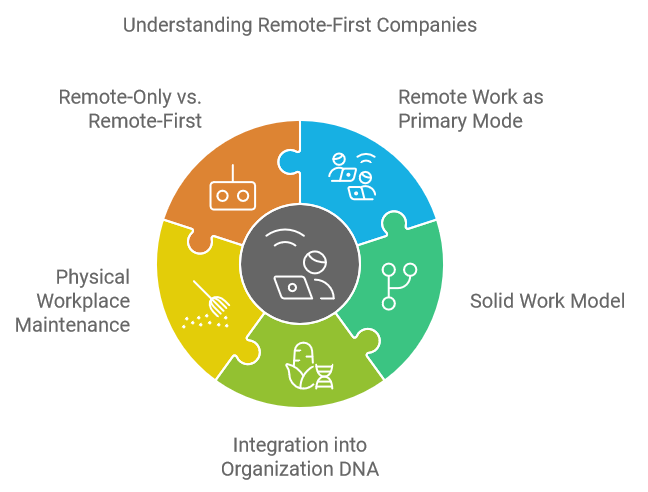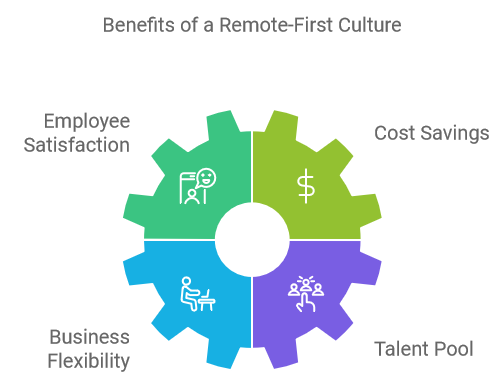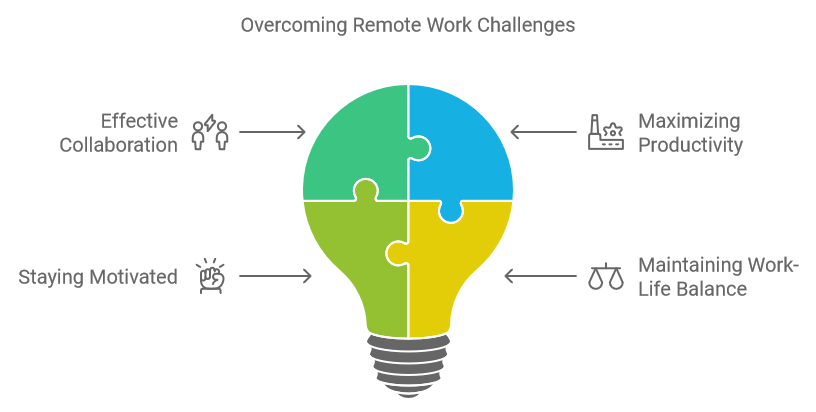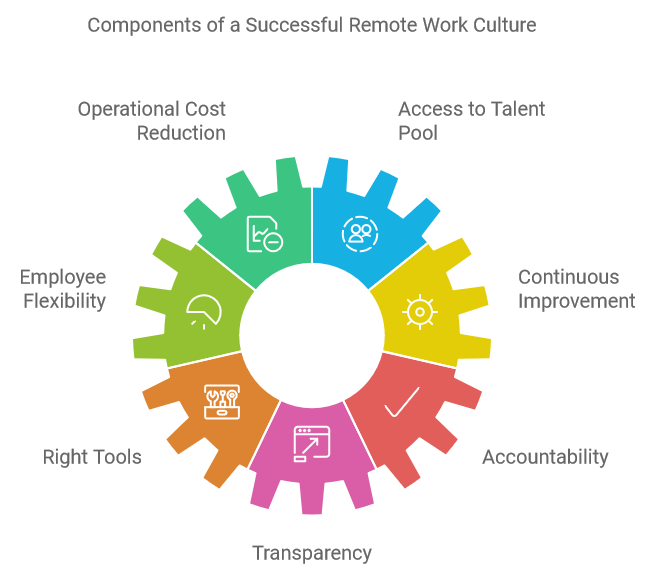The Ultimate Guide to Building a Remote-First Culture
6 min read
There’s no doubt that COVID-19 revolutionized the working culture. For starters, it changed the outlook of employees and employers on remote working, ultimately impacting the future of the workplace. In fact, statistics reveal that more than 70% of professionals expect remote working to become the new standard. There are also new hybrid work models being rolled out by major companies, including Google. This is why it’s not surprising that most corporations are adopting a remote-first culture.
In this guide, we’ll highlight everything you need to know about building a remote-first culture, including what it entails, the main benefits of implementing this model, and how it’s different from a remote-friendly culture.

What Is a Remote-First Company?

For a company to implement a remote-first culture, it has to treat remote working as its primary mode of operation for most or all of its employees. This means forming a solid work model that makes remote working feel normal or natural and then integrating it into the DNA of your organization. So, even though some employees will have to work from a centralized location, most of them will be working from their home offices or co-working spaces.
You should, however, note that remote-first and remote-only cultures are two different concepts. Unlike remote only-organizations, if you implement a remote-first culture, you’ll have to maintain a physical workplace that’s accessible to employees that need a traditional workspace. Most of your employees will, however, be working remotely.
How Is Remote-First Different From Remote-Friendly Culture?

As a remote-first company, remote working is your default mode of operation rather than an occasional practice or a perk. So, you tailor all your operations around a seamless working experience irrespective of the location of your employees. On the other hand, remote-friendly organizations allow or enable some employees to work from home, but most of their daily operations are conducted at the corporate offices.
For instance, a remote-first company could only have the receptionist and the department heads working in the office. A remote-friendly company, however, will likely have a permanent workforce in the corporate offices but still hire remote employees for some tasks. They could also set aside specific days where employees are allowed to work from home but ensure the majority of them are available in the office.
What Are the Top Benefits of a Remote-First Culture?

Thanks to modern technology, building a remote-first culture is now very attainable. In fact, most businesses are implementing this model due to its clear-cut benefits.
Here are the main reasons you should become a remote-first company.
- Higher rates of employee satisfaction: Remote-first employees rarely have to deal with high transport costs and long commute times, ultimately enhancing their quality of life. They’re also able to work around their schedules, thereby boosting their work outlook and increasing their productivity.
- Impressive cost savings: Companies that adopt a remote-first approach are able to significantly decrease their physical footprint, ultimately reducing their operational costs. For instance, if your firm has 7,000 employees and 85% of them are working remotely, you can reduce your working space and lease a much smaller office.
- Increased business flexibility: Most companies have a hard time scaling up because it also means getting larger physical spaces, more infrastructure & complex equipment. With a remote-first culture, however, you’re not limited by the size of your office. Instead, you simply need to increase the size of your workforce. This working model also integrates seamlessly with your business continuity plan because you’ll be fully equipped with the necessary culture and tools to achieve your goals without the employees having to access a central workplace.
- A vast talent pool: As a remote-first company, you have access to a deeper pool of talent because you don’t have to hire within your immediate geographic location. This allows you to attract and retain prime talent even in cases where there’s a shortage of qualified local candidates, especially in areas such as specialized IT roles.
A remote-first culture also equips you with the adaptability to keep up with changing work cultures. This is further enhanced by technological advancements that allow you to maintain a connected workforce even when most of them are working remotely.
What Are the Issues Faced by Remote Teams?

Before you adopt a remote-first culture, you need to identify and stay on top of the challenges in managing remote employees. This way, you’ll significantly eliminate the number of unforeseen interruptions, making your work model more sustainable.
Here’s a quick overview of the most prominent remote working challenges as well as solutions on how to overcome them.
- Effective collaboration: When your employees are spread out across multiple locations, it’s often difficult for them to work on projects together, especially when they’re in different time zones. You can, however, solve this challenge by creating effective communication channels. Unfortunately, emails don’t cut it, so you’ll have to look for flexible, instant, and responsive communication tools.
- Maximizing productivity: Remote workers, especially those that work from home, face several distractions that can impact their productivity. The good news is that there are practical productivity tools that you can use to keep tabs on your employees. However, it would help if you also encouraged them to set daily goals and focus on achieving them instead of working on multiple projects at once.
- Staying motivated: Since remote workers are usually unsupervised, if they’re not self-driven, their projects will slow down. They also experience loneliness, which further contributes to their lack of motivation. To solve this, encourage the team leaders to motivate their teams and hold regular meetings where the workers can interact.
- Maintaining a healthy work-life balance: Remote workers are often prone to overworking. In fact, a recent study revealed that about 70% of employees that transitioned to remote working due to the pandemic now also work over the weekend. This is not only unhealthy but could also result in mental health concerns. Encourage your employees to take regular breaks and engage in leisure activities.
Remote workers also struggle with FOMO (fear of missing out). They often feel as though the employees at the office have better opportunities than them. To solve this challenge, make sure you hold regular and consistent company meetups. They could be physical or virtual.
How Can You Create a Remote Culture?
Download the Work-from-Home IT Toolkit
There’s more to creating a remote-first culture than simply asking some of your employees to work from home. You should also develop structures to ensure that this work model is sustainable for your company in the long run. For instance, you need to create a work environment where your remote employees don’t feel like external resources and collaborate easily. This means getting the proper tech infrastructure, creating the right processes, and providing equal opportunities to remote and in-house employees.
Here are three pillars that you should use to create a remote-first culture effectively.
Trust, Autonomy, and Inclusivity
The success of your remote-first culture is highly dependent on trust. So, build a culture where your employees have the freedom to choose their work hours and preferred working location. However, make sure you also refrain from micromanaging employees as this could quickly breed mistrust, thereby eroding your work culture. This means that while you should use employee monitoring tools, you should steer clear of those that seem invasive.
Keep in mind that trust goes both ways. So, your employees should also trust you as much as you trust them. You can achieve this by maintaining transparency. Keep virtual paper trails of all company decisions, events & activities, and make sure your remote employees are in the loop.
Bringing visibility and increasing accountability in your remote teams is key to building trust and inclusivity. Employee time tracking software such as HiveDesk help in bringing visibility and accountability to remote teams.
Maintain Transparent Communication
Adapt all your communication channels to suit a virtual workplace. This is because even though some employees will be at your offices, most of them will be working remotely. So, you should find a way of keeping them connected to the entire organization. Use asynchronous communication tools. This way, all communications will be documented, and everyone will have access.
If you have various teams working on multiple projects, encourage the team leaders to hold regular meetings. This will allow the remote workers to interact, reducing the loneliness that plagues most of them.
Create Virtual Networks and Encourage Virtual Bonding
You need to be very intentional about fostering interaction among your remote workers. Since they are not in a central location, they don’t get to experience healthy human interactions that are common in offices. Unfortunately, this often causes them to feel as though they’ve been cut off from the company.
Make sure you create several opportunities for them to interact. This could be in the form of virtual events, friendly competitions, social events, etc. You should also hold at least one physical event every year where all your employees can have casual conversations and positive interactions.
We put together a list of team building activities for remote teams that can increase bonding and collaboration.
Reimagining the Post-pandemic Remote Workforce

Even though the pandemic restrictions have loosened and employees can now work at the office, remote working is definitely more advantageous. It reduces a significant chunk of your operational costs, gives you access to a deeper talent pool, and gives your employees the flexibility to work around their schedule. This is why it’s not surprising that most organizations are embracing a remote-first culture.
You should, however, note that it’s not as easy as checking a few things off your to-do list. It’s a work in progress, and you need to nurture & invest in it. This means getting the right tools to help you create solid structures. If you’re looking for a remote employee monitoring tool that will help you foster accountability & transparency, then we’d love to help. Get started with our free trial today!
